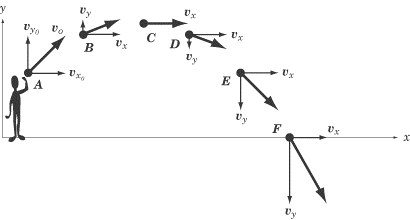If you’ve got the hang of 1-D motion, you should have no trouble at all with 2-D motion. The motion of any object moving in two dimensions can be broken into x- and y-components. Then it’s just a matter of solving two separate 1-D kinematic equations.
The most common problems of this kind on SAT II Physics involve projectile motion: the motion of an object that is shot, thrown, or in some other way launched into the air. Note that the motion or trajectory of a projectile is a parabola.

If we break this motion into x- and y-components, the motion becomes easy to understand. In the y direction, the ball is thrown upward with an initial velocity of ![]() and experiences a constant downward acceleration of g = –9.8 m/s2. This is exactly the kind of motion we examined in the previous section: if we ignore the x-component, the motion of a projectile is identical to the motion of an object thrown directly up in the air.
and experiences a constant downward acceleration of g = –9.8 m/s2. This is exactly the kind of motion we examined in the previous section: if we ignore the x-component, the motion of a projectile is identical to the motion of an object thrown directly up in the air.
In the x direction, the ball is thrown forward with an initial velocity of ![]() and there is no acceleration acting in the x direction to change this velocity. We have a very simple situation where
and there is no acceleration acting in the x direction to change this velocity. We have a very simple situation where ![]() and
and ![]() is constant.
is constant.
SAT II Physics will probably not expect you to do much calculating in questions dealing with projectile motion. Most likely, it will ask about the relative velocity of the projectile at different points in its trajectory. We can calculate the x- and y-components separately and then combine them to find the velocity of the projectile at any given point:
![]()


